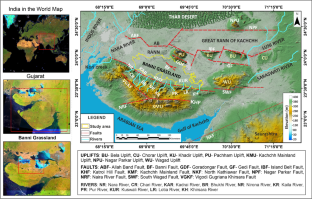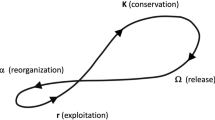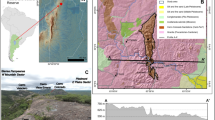Abstract
Awareness of geoheritage, geoconservation, and geotourism research has significantly increased globally during the past two decades. A peri-cratonic Kachchh rift basin in western India exposes varied geological formations and structures, from the Jurassic to Recent. Kachchh basin is characterized by rocky uplifts and pediments with deciduous and scanty forest, which suggest a semi-arid climate while hypersaline Rann and Banni plains show an arid to hyper-arid climate. The deteriorating grasslands of Banni were known as Savanna-type grasslands of Asia. Several natural and anthropogenic factors have led to its depletion. Owing to its unique geological, aesthetic, botanical and cultural values, the Banni Grasslands hold a potential candidature for a critical geo-observatory site status, both at national and international levels. The geological evolutionary history of this fragile eco-zone with a strong anthropological background calls for a holistic sustainable development that encompasses the socio-economical needs and ecological agility at the same time. The plains of Banni are unique geomorphic features with distinct ecology, traditional climate-human sustainable practice model and diverse folk arts and skills of making climate-tectonic resistive dwellings. The grasslands to the north merge into the marshes and uplifted mudflats as the Rann terrain. The present paper is an attempt to understand the socio-economic intricacies of Banni grassland in light of its unique geological origin and ecological vulnerabilities. It focuses on traditional and sustainable ecological knowledge of the local folks with distinct harmony of their art and architecture so interwoven with the activeness of the climate and tectonics of Banni. The inter-sectorial conflicting interests have redefined the fate of this terrain, in recent decades. It presents the status quo of its geological, anthropological and ecological facets and establishes the way forward that sustains the social, economic and above all ecological obligations in the long run.










Similar content being viewed by others
Data Availability
All data supporting the findings of this study are available within the paper.
References
Bharwada C, Mahajan V (2012) Let it be Banni: understanding and sustaining pastoral livelihoods of Banni. In: Research unit for livelihoods and natural resources
Bhosale S, Chaskar K, Pandey DK, Lakhote A, Thakkar A, Chauhan G, Bhandari S, Thakkar MG (2021) Jurassic geodiversity and geomorphosite of Kanthkot area, Wagad, kachchh, western India. Int J Geoheritage Parks 9(1):51–68
Biswas SK (1974) Landscape of Kachchh – a morphotectonic analysis. Ind Jour Earth Sci 1(2):177–190
Biswas SK (1987) Regional tectonic framework, structure and evolution of the western marginal basins of India. Tectonophysics 135:307–327
Biswas SK (2016) Mesozoic and tertiary stratigraphy of Kutch*(Kachchh)–A review. In: Conference GSI, pp 1–24. https://doi.org/10.17491/cgsi/2016/105405
Biswas SK, Chauhan G (2021) The Kutch Rift Basin–Potential location for a national Geopark of India. In: A monograph on potential Geoparks of India. Indian National Trust for Art and Cultural Heritage (INTACH), New Delhi, pp 1–36
Brocx M, Semeniuk V (2007) Geoheritage and geoconservation-history, definition, scope and scale. J R Soc West Aust 90(2):53–87
Burnes A (1839) Travels to Bokhara-Also a narrative of a voyage on the Indus, vol 1. John Murray, London, p 308
Chandel P, Anand S, Singh D (2022) An overview of scientific research on geoheritage in India. Geoheritage 14(4):131
Chauhan S, Desai B (2023) Geosites of the Early Cretaceous (Bhuj Formation) based on their ichnological values: insights from the Kachchh Basin, Western India. Geoheritage 15(1):9
Chauhan G, Biswas SK, Thakkar MG, Page KN (2021) The unique geoheritage of the Kachchh (Kutch) Basin, Western India, and its conservation. Geoheritage 13:1–34
Chavan A, Sarkar S, Thakkar A, Solanki J, Jani C, Bhandari S, Bhattacharya S, Desai BG, Ray D, Shukla AD (2022) Terrestrial Martian analog heritage of Kachchh basin, Western India. Geoheritage 14(1):33
Chowksey V, Maurya DM, Joshi P, Khonde N, Das A, Chamyal LS (2011) Lithostratigraphic development and neotectonic significance of the Quaternary sediments along the Kachchh Mainland Fault (KMF) zone, western India. J Earth Syst Sci 120:979–999
Desai BG, Chaudhary A, Chauhan S, Singh A (2023) Exploring the Geoheritage and Geosites of Jaramara area, Kachchh, India: a window into the Mesozoic rift basin. Geoheritage 15(4):135
Geoparks UG (2016) UNESCO global geoparks. Celebrating earth heritage, sustaining local communities. UNESCO, Paris
Goldstein PZ (1999) Functional ecosystems and biodiversity buzzwords. Conserv Biol 13(2):247–255
Gordon JE, Crofts R, Díaz-Martínez E (2018) Geoheritage conservation and environmental policies: retrospect and prospect. In: Geoheritage. Elsevier, pp 213–235. https://doi.org/10.1016/B978-0-12-809531-7.00012-5
Ibáñez J-J, Brevik EC, Cerdà A (2019) Geodiversity and geoheritage: detecting scientific and geographic biases and gaps through a bibliometric study. Sci Total Environ 659:1032–1044
Jiao Y, Ding Y, Zha Z, Okuro T (2019) Crises of biodiversity and ecosystem services in Satoyama landscape of Japan: a review on the role of management. Sustainability 11(2):454
Joshi PN, Bhatti R, Das S (2020) Traditional conservation of Buffalo Breed by pastoralists through maintaining of grassland ecosystem, Banni-Kachchh, Gujarat-India. https://uknowledge.uky.edu/igc/23/3-5-1/9/
Joshi PN, Kumar V, Koladiya M, Patel YS, Karthik T (2009) Local perceptions of grassland change and priorities for conservation of natural resources of Banni, Gujarat, India. Front Biol China 4(4):549–556
Kar A (1993) Neotectonic influences on the morphological variations along coastline of Kachchh, India. Geomorphology 8:199–219
Kar A (2001) Characteristics of major soils of Banni mudflat in arid western India and their relationship with topography. J Arid Environ 48(4):509–520. https://doi.org/10.1006/jare.2000.0765
Kapur VV, Chauhan G (2024) Miocene (~ 14 Ma) vertebrate-yielding site of Palasava, Kachchh, Gujarat State, Western India: Geoheritage-Geotourism perspectives and Geosite Potential. Geoheritage 16(1):12
Makwana N, Prizomwala SP, Das A, Phartiyal B, Sodhi A, Vedpathak C (2021) Reconstructing the climate variability during the last 5000 years from the Banni Plains, Kachchh, Western India. Front Earth Sci 9(July):1–11. https://doi.org/10.3389/feart.2021.679689
Manjunatha BL, Shamsudheen M, Sureshkumar M, Tewari P, Yadav OP (2019a) Occupational structure and determinants of household income of pastoralists in Bannigrasslands of Gujarat. Indian J Anim Sci 89(4):453–458
Manjunatha BL, Sureshkumar M, Tewari P, Dayal D, Yadav OP (2019b) Livestock population dynamics in Banni grasslands of Gujarat. Indian J Anim Sci 89(3):319–323
Mathur M, Sharma K (2018) Modelling the economics of grassland degradation in Banni, India, using system dynamics. Ecol Econ Soc–INSEE J 1(2):31–65
Maurya DM, Khonde N, Das A, Chowksey V, Chamyal LS (2013) Subsurface sediment characteristics of the Great Rann of Kachchh, western India based on preliminary evaluation of textural analysis of two continuous sediment cores. Curr Sci 104:1071–1077
Maurya DM, Tiwari M, Rajawat AS, Kumar H, Khonde N, Chamyal LS (2016) Geomorphic characterization of the Banni Plain, Kachchh, using orbital imaging radar (RISAT 1C) and optical remote sensing data. In: Conference GSI, pp 168–178
Mehta A, Sinha M, Chaudhary R (2014) Evaluation of land cover changes in Banni grassland using GIS and RS Technology-A Case Study. Bull Environ Sci Res 3(4):18–27
Muduli GP, Kumari M, Mahalakshmi T (2022) Assessment of potential geoheritage sites, promotion of geotourism and geoconservation of Kachchh district, India. Geoconserv Res 5(1):142–164
Ngangom M, Thakkar MG, Bhushan R, Juyal N (2012) Continental–marine interaction in the vicinity of the Nara River during the last 1400 years, Great Rann of Kachchh, Western India. Curr Sci:1339–1342
Page KN (2018) Fossils, heritage and conservation: managing demands on a precious resource. In: Geoheritage, pp 107–128. https://doi.org/10.1016/B978-0-12-809531-7.00006-X
Pandey A, Mahato A (2019) Restoration potential of degraded inland sacred forest of Kachchh, Gujarat: an evidence of Shravan Kavadiya Sacred grove. Int J Pharm Biosci 10(3):118–171
Pereira Balaguer L, da Glória Motta Garcia M, de Almeida Leite M, Ribeiro L (2022) Combined assessment of geodiversity as a tool to territorial management: application to southeastern coast of state of São Paulo, Brazil. Geoheritage 14(2):60
Pillai AA, Anoop A, Prasad V, Manoj MC, Varghese S, Sankaran M, Ratnam J (2018) Multi-proxy evidence for an arid shift in the climate and vegetation of the Bannigrasslands of western India during the mid-to late-Holocene. Holocene 28(7):1057–1070
Prizomwala SP, Tandon A, Kazmer M, Makwana N, Solanki T, Chauhan G (2022) Geoheritage Potential of miliolite formation of the southern Saurashtra (Western India), Gujarat. Geoheritage 14(4):127
Rajendran K, Rajendran CP, Thakkar M, Tuttle MP (2001) The 2001 Kutch (Bhuj) earthquake: coseismic surface features and their significance. Curr Sci:1397–1405
Rajendran K, Rajendran CP, Thakkar M, Gartia RK (2002) Sand blows from the 2001 Bhuj earthquake reveal clues on past seismicity. Curr Sci 83(5):603–609
Rajendran CP, Rajendran K, Thakkar M, Goyal B (2008) Assessing the previous activity at the source zone of the 2001 Bhuj earthquake based on the near-source and distant paleoseismological indicators. J Geophys Res Solid Earth 113(B5)
Reynard E (2003) Geosite. In: Goudie AS (ed) Encyclopedia of geomorphology. Routledge, London
Sallam ES, Ruban DA, Ermolaev VA (2022) Geoheritage resources and new direction of infrastructural growth in Egypt: from geosite assessment to policy development. Resour Policy 79:103127
Sangathan BPUM (2013) The biocultural community protocol of the Maldharis of Banni. https://www.sahjeevan.org/images/files/animal_husbandry/02_BCP_ENGLISH.pdf. Accessed 28 Feb 2022
Sant DA, Parvez IA, Rangarajan G, Patel SJ, Bhatt MN, Sanoop Salam TA (2017) Subsurface profiling along Banni Plains and bounding faults, Kachchh, Western India using microtremors method. J Asian Earth Sci 146(May 2016):326–336. https://doi.org/10.1016/j.jseaes.2017.06.002
Singh YD (2004) Grassland action plan for Kachchh District, Gujarat State, vol 1.Gujarat Institute of Desert Ecology, Bhuj-Kachchh
Shekhar S, Kumar P, Chauhan G, Thakkar MG (2019) Conservation and sustainable development of Geoheritage, Geopark, and Geotourism: a case study of Cenozoic successions of Western Kutch, India. Geoheritage 11(4):1475–1488
Stanley OD (2004) Wetland ecosystems and coastal habitat diversity in Gujarat, India. J Coast Dev 7(2):49–64
Swarna K, Biswas SK, Harinarayana T (2013) Development of geotourism in Kutch Region, Gujarat, India: an innovative approach. J Environ Prot 4(12):1360–1372
Thakkar MG (2017) Geomorphological field guide book on Kachchh Peninsula (Edited by Amal Kar). Indian Institute of Geomorphologists, Allahabad
Thakkar MG (2018) Gujarat earthquake: ground deformation. In: Natural hazards. CRC Press, pp 1–28
Thakkar M, Thakkar MG, Goyal B (2004) On the relation between magnitude and liquefaction dimension at the epicentral zone of 2001 Bhuj earthquake. Curr Sci:811–817
Thakkar MG, Goyal B, Maurya DM, Chamyal LS (2012) Internal geometry of reactivated and non-reactivated sandblow craters related to 2001 Bhuj earthquake, India: a modern analogue for interpreting paleosandblow craters. J Geol Soc India 79:367–375
Thakkar A, Jadeja JM, Rajesh SV, Ch van A, Abhayan GS, Bhandari S, Chauhan G, Thakkar MG (2022) Geoarchaeological heritage of Kachchh region, Gujarat, Western India: geotourism potentials. Geoheritage 14(4):128
Tuttle MP, Hengesh JV (2002) Liquefaction. Earthq Spectra 18:79–100
Tuttle MP, Johnston A, Rajendran C, Rajendran K, Thakkar M (2001) Liquefaction features induced by the Republic Day earthquake, India, and comparison with features related to the 1811-1812 New Madrid, Missouri, earthquakes. AGU Spring Meeting Abstracts, 2001, S22A-09
Yahya Sheibani V, Zamanian E (2023) Geodiversity and geological treasure of Tabas UNESCO Global geopark for geotourism development, new UGGp from Iran. Geoheritage 15(3):106
Acknowledgements
The authors express their sincere gratitude to the anonymous reviewers and the editor for their invaluable comments and suggestions, which greatly contributed to improving the quality of this paper. Special thanks are extended to the Education Department, Government of Gujarat, for providing the SHODH Fellowship to Rupak Dey, enabling him to pursue his Ph.D. research work. The authors would also like to extend their heartfelt appreciation to the local community of Banni for their generous assistance in comprehending the intricacies of this unique region. Their invaluable insights greatly enhanced the authors' understanding of the distinct characteristics of this terrain. Furthermore, the authors are grateful to the various non-governmental organizations (NGOs) that have actively worked in Banni. Their valuable contributions and shared knowledge played a vital role in facilitating a deeper comprehension of the true essence of this remarkable landscape. This paper forms a part of the Doctoral Thesis of Mr. Rupak Dey.
Author information
Authors and Affiliations
Contributions
All the authors have participated in the field, generated data regarding the manuscript and prepared all the figures and drafted the manuscript.
Corresponding author
Ethics declarations
Conflict of Interest
On behalf of all co-authors, I confirm that all authors made an equal contribution. There is no conflict of interest between the co-authors.
Rights and permissions
Springer Nature or its licensor (e.g. a society or other partner) holds exclusive rights to this article under a publishing agreement with the author(s) or other rightsholder(s); author self-archiving of the accepted manuscript version of this article is solely governed by the terms of such publishing agreement and applicable law.
About this article
Cite this article
Dey, R., Sharma, S.B., Thakkar, M.G. et al. Banni Grassland, a Geoheritage Landscape of Western India: Endless Possibilities for Geo-Eco-Socio Tourism. Geoheritage 16, 52 (2024). https://doi.org/10.1007/s12371-024-00945-x
Received:
Accepted:
Published:
DOI: https://doi.org/10.1007/s12371-024-00945-x




